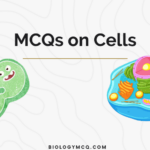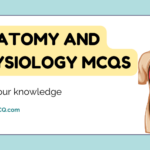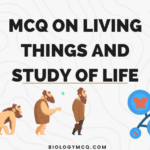Study and Learn with 1000s of Biology MCQs
Anatomy MCQs

Anatomy MCQs are covered in detail on this page.
Anatomy is the branch of biology concerned with the structure of organisms and their parts. It provides the foundation for understanding how different body systems work together to maintain life.
Multiple choice questions answers are a quick way to analyze your knowledge and understanding on a topic. For Anatomy (a branch of biology) we will dissect it into its branches so it can be easier for you to study our prepared multiple choice questions for each one separately and in detail.
Branches of Anatomy and their MCQs
| Comparative Anatomy MCQs | Embryology MCQs |
| Gross Anatomy MCQs | Histology MCQs |
| Human Anatomy MCQs | Phytotomy MCQs |
| Plant Anatomy MCQs | Regional Anatomy MCQs |
| Systemic Anatomy MCQs | Zootomy MCQs |
MCQs on Anatomy
Here you will find some mcq questions answers based on general anatomy. These questions will scratch the surface of this vast subject and give you an overall idea of how good is your basic understanding of this subject. So lets start with questions given below.
_ is the study of body structure, which includes size, shape, composition, and perhaps even coloration.
Physics
Cell Biology
Anatomy
Morphology
Anatomy
The word “anatomy” comes from a Greek root that means __
To Explore
To cut apart
To Think deep
Human body
To cut apart
_ anatomy is the study of the larger structures of the body, those visible without the aid of magnification.
Net
Gross
Total
Human
Gross
A __ is the smallest independently functioning unit of a living organism.
Cell
Atom
Molecule
Proton
Cell
A human cell typically consists of a water-based cellular fluid together with a variety of tiny functioning units called __
Mitochondria
Species
Organelles
None of above
Organelles
__ is a group of many similar cells (though sometimes composed of a few related types) that work together to perform a specific function.
Tissue
Muscle
Skeleton
Organelles
Tissue
__ covers the body surfaces, lines internal organs and cavities, and forms glands.
Epithelial tissues
Connective tissues
Muscle tissues
Nerve tissue
Epithelial tissues
_ provides support and connects different structures of the body.
Epithelial tissues
Connective tissues
Muscle tissues
Nerve tissue
Connective tissues
__ is responsible for movement and locomotion.
Epithelial tissues
Connective tissues
Muscle tissues
Nerve tissue
Muscle tissues
_ consists of neurons and glial cells.
Epithelial tissues
Connective tissues
Muscle tissues
Nerve tissue
Regional anatomy
An _ work together to perform major functions or meet physiological needs of the body
Cardiac system
Lymphatic system
Immune system
Organ system
Organ system
__ is the study of how the body functions.
Anatomy
Physiology
Histology
Biology
Physiology
__ is the study of the interrelationships of all of the structures in a specific body region, such as the abdomen.
Systemic anatomy
Regional anatomy
Histology
Gross Anatomy
Regional anatomy
_ is the study of the structures that make up a discrete body system.
Systemic anatomy
Regional anatomy
Histology
Gross Anatomy
Systemic anatomy
__ study of the muscular system would consider all of the skeletal muscles of the body.
Systemic anatomy
Regional anatomy
Histology
Gross Anatomy
Systemic anatomy
Which system encloses internal body structures and is the site of many sensory receptors ?
Skeletal system
Integumentary system
Muscular system
Nervous system
Integumentary system
Which system supports the body and enables movement with the help of muscular system ?
Skeletal system
Integumentary system
Muscular system
Nervous system
Skeletal system
Skeletal system consists of _
muscles, tendons
bones, ligaments
brain, nerves, eyes, ears
gland, pancreas
bones, ligaments
Which system enables human body to move with help of skeletal system
Skeletal system
Integumentary system
Muscular system
Nervous system
Muscular system
Muscular system consists of __
muscles, tendons
bones, ligaments
brain, nerves, eyes, ears
gland, pancreas
muscles, tendons
The system that detects and processes sensory information and activates bodily responses is known as __
Skeletal system
Integumentary system
Muscular system
Nervous system
Nervous system
Nervous system consists of __ ?
muscles, tendons
bones, ligaments
brain, nerves, eyes, ears
gland, pancreas
brain, nerves, eyes, ears
Hormones are secreted by __ system and it also regulates bodily processes
Skeletal system
Integumentary system
Muscular system
Endocrine system
Endocrine system
Endocrine system consists of _ ?
muscles, tendons
bones, ligaments
thyroid gland, pituitary gland, pancreas
gland, pancreas
thyroid gland, pituitary gland, pancreas
__ system delivers oxygen and nutrients to tissues.
Skeletal system
Cardiovascular system
Integumentary system
Muscular system
Cardiovascular system
Cardiovascular system consists of __ ?
muscles, tendons
bones, ligaments
gland, pancreas
heart, blood, arteries
heart, blood, arteries
__ system defends against pathogens and returns fluid to blood.
Skeletal system
Integumentary system
Muscular system
Lymphatic system
spleen, lymph nodes
Lymphatic system consists of _ ?
bones, ligaments
gland, pancreasRespiratory system
heart, blood, arteries
spleen, lymph nodes
spleen, lymph nodes
__ sytem removes carbon dioxide from body and deliver oxygen to blood
Integumentary system
Respiratory system
Muscular system
Lymphatic system
Respiratory system
Respiratory system consists of __ ?
bones, ligaments
gland, pancreas
lungs, trachea, larynx, diaphragm
heart, blood, arteries
lungs, trachea, larynx, diaphragm
Wastes from undigested food is removed by __ system and it also processes food for use by the body.
Integumentary system
Digestive system
Muscular system
Lymphatic system
Digestive system
Digestive system consists of __ ?
bones, ligaments
stomach, colon, liver, pancreas
gland, pancreas
heart, blood, arteries
stomach, colon, liver, pancreas
_ system controls water balance in the boday and removes wastes from blood and excretes them.
Urinary system
Integumentary system
Muscular system
Lymphatic system
Urinary system
Urinary system consists of _ ?
bones, ligaments
kidneys, urinary bladder, urethra
gland, pancreas
heart, blood, arteries
kidneys, urinary bladder, urethra
Male __ system produces reproductive hormones and gametes. It also delivers gametes to female.
Reproductive System
Integumentary system
Muscular system
Lymphatic system
Reproductive System
Female __ system produces reproductive hormones and gamets. It also supports embryo/fetus until birth.
Reproductive System
Integumentary system
Muscular system
Lymphatic system
Reproductive System
Which system transports oxygen and nutrients to tissues and removes waste products ?
Reproductive System
Integumentary system
Muscular system
Circulatory system
Circulatory system
__ is a barrier to pathogens and chemicals and Prevents excessive water loss
Reproductive System
Integumentary system
Muscular system
Circulatory system
Integumentary system
Integumentary system consists of _ ?
Skin, subcutaneous tissue
Skeleton
Muscles
Heart and veins
Skin, subcutaneous tissue
Metabolism is the sum of all _ and _ reactions that take place in the body
Anabolic
Catabolic
Both A & B
None of these
Both A & B
A nutrient is a substance in foods and beverages that is essential to human survival.
Protein
Nutrient
Mineral
Sugar
Nutrient
A person who is in good health may be said to be in a state of homeostasis.
Polyostasis
Homeostasis
Multiostasis
None of these
Homeostasis
Homeostasis reflects the ability of the body to maintain a relatively ____ metabolism and to function normally despite many constant changes.
Unstable
Stable
Variable
Any of these
Stable
In a _ feedback mechanism, the response to the stimulus does not stop or reverse the stimulus, but instead keeps the sequence of events going.
Negative
Neutral
Positive
Any of these
Negative
In a __ feedback mechanism, body’s response reverses the stimulus (in effect, turning it off for a while) and keeps some aspect of the body metabolism within its normal range.
Negative
Neutral
Positive
Any of these
Negative
Cardiac is referred to _
Heart
Skin
Stomach
Nose
Heart
Cutaneous is referred to _
Heart
Skin
Stomach
Nose
Skin
Gastric is referred to _
Heart
Skin
Stomach
Nose
Stomach
Lumbar is referred to _
Small of back
Skin
Stomach
Nose
Small of back
Nasal is referred to _
Heart
Skin
Stomach
Nose
Nose
Pedal is referred to _
Skin
Stomach
Nose
Foot
Foot
Temporal is referred to _
Skin
Side of head
Stomach
Nose
Side of head
Renal is referred to _
Skin
Stomach
Nose
kidney
kidney
Anterior means _ ?
toward the front
toward the back
toward the left
toward the right
toward the front
The chest is on the __ side of the body.
Peripheral
Anterior
Parietal
Any of these
Anterior
Peripheral means _ ?
extending from the front part
extending from the main part
extending from the back part
None of these
extending from the main part
Nerves in the arm are part of the _ nervous system.
Peripheral
Anterior
Parietal
Any of these
Peripheral
Parietal means _ ?
pertaining to the anywhere in a cavity
pertaining to the back of a cavity
pertaining to the wall of a cavity
pertaining to the front of a cavity
pertaining to the wall of a cavity
The parietal pleura lines the _ cavity.
Lungs
stomach
chest
Any of these
chest
Organs in the __ cavity include the heart and lungs.
Chest cavity
Thoracic cavity
Abdominal cavity
Dorsal Cavity
Thoracic cavity
The membranes of the __ are serous membranes called the pleural membranes.
Chest cavity
Abdominal cavity
Thoracic cavity
Dorsal Cavity
Thoracic cavity
The heart has its own set of serous membranes called the __ membranes.
Thoracic
Pericardial
Dorsal
Chest
Pericardial
Organs in the __ cavity include the liver, stomach, and intestines.
Chest cavity
Abdominal cavity
Thoracic cavity
Dorsal Cavity
Abdominal cavity
The pelvic cavity is inferior to the abdominal cavity.
Pelvic cavity
Abdominal cavity
Thoracic cavity
Dorsal Cavity
Pelvic cavity
Within the _ are the urinary bladder and reproductive organs such as the uterus in
women and the prostate gland in men.
Abdominal cavity
Thoracic cavity
Pelvic cavity
Dorsal Cavity
Pelvic cavity
__ is lined with membranes called Meninges and consists of the cranial and vertebral
cavities.
Cranial cavity
Vertebral cavity
Thoracic cavity
Dorsal Cavity
Dorsal Cavity
_ cavity contains the brain.
Cranial cavity
Vertebral cavity
Thoracic cavity
Dorsal Cavity
Cranial cavity
__ cavity contains the spinal cord.
Cranial cavity
Vertebral cavity
Thoracic cavity
Dorsal Cavity
Vertebral cavity
The diaphragm separates the thoracic and abdominal cavities.
Cranial cavity
Thoracic cavity
Abdominal cavity
Thoracic cavity
Thoracic cavity
Abdominal cavity
The pelvic cavity is __ to the abdominal cavity.
Superior
inferior
Outside
Inside
inferior
_ cavity contains the lungs and heart.
Cranial cavity
Thoracic cavity
Abdominal cavity
Thoracic cavity
Thoracic cavity
__ membranes line the chest wall and cover the lungs.
Abdominal
Pleural
Pericardial
Cranial
Pleural
__ membranes surround the Heart.
Abdominal
Pleural
Pericardial
Cranial
Pericardial
_ cavity contains many organs including the stomach, liver, and intestines.
Abdominal
Pleural
Pericardial
Cranial
Abdominal
__ cavity contains the urinary bladder and reproductive organs.
Abdominal
Pleural
Pelvic
Cranial
Pelvic



